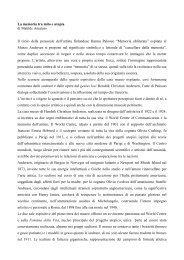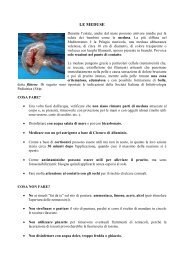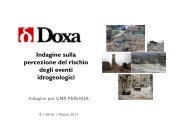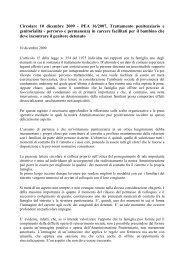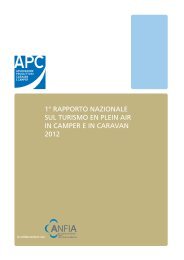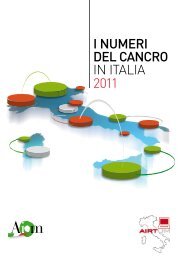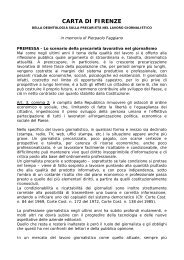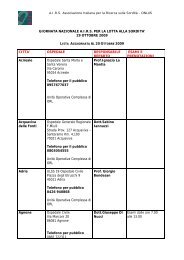Giotto firmò la Sacra Sindone - Nannimagazine.it
Giotto firmò la Sacra Sindone - Nannimagazine.it
Giotto firmò la Sacra Sindone - Nannimagazine.it
You also want an ePaper? Increase the reach of your titles
YUMPU automatically turns print PDFs into web optimized ePapers that Google loves.
G iotto firmò<strong>la</strong><strong>Sacra</strong> S indonea cura di Luciano BusoEDIZIONI
Tutti i dir<strong>it</strong>ti sono riservatiNessuna parte di questa pubblicazione può essere usata in qualsiasi forma ocon qualsiasi mezzo, grafico, elettronico o meccanico, inclusa <strong>la</strong> fotocopiatura, <strong>la</strong>registrazione su nastro o dig<strong>it</strong>ale, delle immagini e dei testi, o con qualsiasi altroprocesso di archiviazione, senza il permesso dello studioso Luciano Buso o dell’ed<strong>it</strong>ore.
G iotto firmò<strong>la</strong><strong>Sacra</strong> S indonea curadiLuciano BusoEDIZIONI ACELUM2
GIOTTO FIRMO’ LA SACRA SINDONEAppena un mese fa ebbi a presentare l’anteprima del volume “firmee date ce<strong>la</strong>te nei dipinti da <strong>Giotto</strong> ai tempi nostri “.Il volume racchiude in sintesi <strong>la</strong> scoperta da me fatta sulle scr<strong>it</strong>tece<strong>la</strong>te presenti nelle opere d’arte di ogni tempo a partire da <strong>Giotto</strong>.Nel discorso da me tenuto durante <strong>la</strong> presentazione del volume,mi ripromisi pubblicamente, vista l’esperienza oggi raggiuntain materia, di svolgere casomai in futuro uno studio sul<strong>la</strong> <strong>Sacra</strong><strong>Sindone</strong>, visti anche i molteplici dubbi nati sin dagli anni ottanta,quando furono esaminati da esperti mondiali alcuni lembi d<strong>it</strong>essuto prelevati dal Sacro Lenzuolo.Da tali esami scientifici emerse <strong>la</strong> probabile datazione del Lenzuoloal periodo medioevale, susc<strong>it</strong>ando al tempo nei media non pochepolemiche e curios<strong>it</strong>à, ma che oggi sarebbe del tutto giustificata,vista <strong>la</strong> comparsa in forma scientifica, del<strong>la</strong> data da me rilevata”15”,“1315”.I miei approfond<strong>it</strong>i studi su tale materia si sono,anno per anno,arricch<strong>it</strong>i del<strong>la</strong> conoscenza, maturando un’esperienza, che miha permesso di rilevare scr<strong>it</strong>te ce<strong>la</strong>te presenti in ogni dipinto, inogni opera d’arte, esegu<strong>it</strong>i dal<strong>la</strong> fine del tredicesimo secolo sino ainostri giorni!Tali studi sono inser<strong>it</strong>i e raccolti nel grande volume da me curato,che ormai volge al termine e da cui è stata estrapo<strong>la</strong>ta l’anteprimaappena ed<strong>it</strong>ata.La miriade di opere da me sinora studiate, analizzate e pubblicate,mi consente, serenamente oggi, di tentare di dipanare i ques<strong>it</strong>iinerenti il “Sacro Lenzuolo” che avvolse il corpo di Gesù.Nel recente infatti, sempre più, si sente par<strong>la</strong>re di presenza discr<strong>it</strong>te ce<strong>la</strong>te nel Lenzuolo, c’è chi, addir<strong>it</strong>tura, afferma essereopera del grande Leonardo da Vinci, comparando il volto di Gesùal celeberrimo autor<strong>it</strong>ratto di Leonardo.Gran parte delle scr<strong>it</strong>te ce<strong>la</strong>te, presenti in ogni opera, le ho messein luce con tecniche e metodologie scientifiche del tutto oneste ever<strong>it</strong>iere, casomai verificabili da chiunque lo r<strong>it</strong>enesse opportuno,come ho già asser<strong>it</strong>o in passato.La scienza oggi ci sorregge ovunque nel nostro quotidiano vivere,ogni giorno abbiamo a che fare con fatti scientifici che ci aiutanoa comprendere cose non visibili ad occhio nudo; permettendomi,così, di individuare, tra le molte scr<strong>it</strong>te criptate presenti nel dipintodi Leonardo da Vinci, “<strong>la</strong> Gioconda”, <strong>la</strong> data di esecuzione, il 1501,già pubblicata nell’ anteprima del volume.Ciò che maggiormente mi sconvolse, durante i miei precedentistudi, sono state <strong>la</strong> miriade di scr<strong>it</strong>te ce<strong>la</strong>te apparse nei dipinti delsommo <strong>Giotto</strong>: “Esaù respinto da Isacco”, “il dono del mantello”,“<strong>la</strong> strage degli innocenti” e “ <strong>la</strong> presentazione di Gesù al tempio”,anch’essi già pubblicati nel<strong>la</strong> anteprima del volume.Un balzo indietro quindi di circa duecento anni dalle scr<strong>it</strong>te criptateapparse nel dipinto del<strong>la</strong> Gioconda.Ora, a circa un mese dal<strong>la</strong> precedente pubblicazione, nell’analizzarein forma scientifica <strong>la</strong> <strong>Sacra</strong> <strong>Sindone</strong>, con giustificato ed enormestupore, r<strong>it</strong>rovo nelle molteplici scr<strong>it</strong>te ce<strong>la</strong>te presenti ovunquenel<strong>la</strong> superficie dell’intero Lenzuolo, <strong>la</strong> stessa grafia, lo stessomodo di apposizione delle scr<strong>it</strong>te ce<strong>la</strong>te, lo stesso modo graficodi esecuzione del numero “15 “, che tempo addietro evidenziai neidipinti di <strong>Giotto</strong>.Non solo, ma ad occupare l’intero volto di Gesù nel<strong>la</strong> <strong>Sindone</strong>,appare <strong>la</strong> totale e chiara scr<strong>it</strong>ta criptata, “<strong>Giotto</strong> 15”.Sbigott<strong>it</strong>o ed incredulo ho analizzato l’intera superficie del SacroLenzuolo, rilevando ovunque altre scr<strong>it</strong>te criptate, sempre lestesse, “<strong>Giotto</strong> 15”.A questo punto, con queste reali certezze, mi sono posto <strong>la</strong>domanda del perchè <strong>Giotto</strong> abbia criptato nell’intero telo i suoi dati,il suo nome, quel<strong>la</strong> data “15”, che in realtà, come nei precedentiaffreschi da me analizzati, risulta essere il 1315.L’unica spiegazione p<strong>la</strong>usibile a tali fatti reali e concreti, è cheil Sacro Lenzuolo sia stato esegu<strong>it</strong>o da <strong>Giotto</strong>, vista anche <strong>la</strong>comparsa del<strong>la</strong> firma ufficiale <strong>la</strong>sciata in un cartiglio nel<strong>la</strong> zona tra3
il mento ed il collo di Gesù.Durante i miei studi, infatti, è comparso appena sotto il mento diCristo, un cartiglio con forma ottagonale allungata e schiacciata,dove al suo interno ho potuto evidenziare, con le mie metodologie,<strong>la</strong> traccia del<strong>la</strong> firma “<strong>Giotto</strong>”.L’artista, quindi, firmò l’opera ufficialmente, così facendo, esclusequalsiasi riferimento o azione mendace di dolo verso il cristianesimo,dichiarando al mondo intero l’appartenenza dell’opera al<strong>la</strong> suamano, al<strong>la</strong> sua bravura, al suo genio!L’ apposizione del<strong>la</strong> miriade di scr<strong>it</strong>te criptate, del tutto simili aquelle rilevate in precedenza nei suoi dipinti, mi induce a pensare adun suo intervento di rifacimento del Sacro Lenzuolo, probabilmentegiustificato dal fatto che l’originale telo fosse arrivato sino aquell’epoca in cattive e pessime condizioni, al punto da richiederneil rifacimento.Mi sentirei di escludere un’iniziativa personale del noto artista nelprogettare e realizzare il Sacro Telo, anche perché, così facendo,avrebbe gravemente offeso l’Immagine <strong>Sacra</strong> di Gesù, <strong>la</strong> chiesa el’intero popolo cristiano nei suoi valori e nei suoi simboli più intimi.Di certo, <strong>la</strong> <strong>Sacra</strong> <strong>Sindone</strong>, che noi tutti conosciamo, è stata realizzatadal grande <strong>Giotto</strong> nel 1315, soprattutto per <strong>la</strong> costruzione graficadel<strong>la</strong> scr<strong>it</strong>ta ce<strong>la</strong>ta che occupa l’intero volto di Cristo, per come<strong>la</strong> scr<strong>it</strong>ta è stata ideata nel comporre il nome <strong>Giotto</strong>, sfruttando lelinee che demarcano i tratti del volto e per come viene inser<strong>it</strong>a <strong>la</strong>data”15” più volte nel<strong>la</strong> scr<strong>it</strong>ta stessa. Nel volto capovolto, oltretutto,appaiono le due grandi scr<strong>it</strong>te <strong>Giotto</strong> a formare una croce, l’unaorizzontale, appena sopra il mento, l’altra verticale, scorre al centrolungo tutto il volto dall’alto al basso, sino al<strong>la</strong> fronte.Oserei par<strong>la</strong>re di grande genial<strong>it</strong>à, grande esecuzione e di grandefinezza p<strong>it</strong>torica!Se noi andiamo a visionare come <strong>Giotto</strong> realizza i baffi di ogni suopersonaggio, vedremo che <strong>la</strong> costruzione grafica e compos<strong>it</strong>iva deibaffi, risulta essere quadrateggiante, proprio come nel volto del<strong>la</strong><strong>Sacra</strong> <strong>Sindone</strong>.Non solo, ma molto vicini al<strong>la</strong> <strong>Sindone</strong> sono, <strong>la</strong> forma delle braccia,delle mani e delle gambe dei vari personaggi dipinti da <strong>Giotto</strong> neisuoi affreschi, l’affin<strong>it</strong>à iconografica risulta essere molto affine.Cosa ancora più rilevante se vogliamo, risulta essere <strong>la</strong> grafiaoriginale di <strong>Giotto</strong>, pubblicata nel precedente studio scientificoinser<strong>it</strong>o nel<strong>la</strong> anteprima del volume da me curato e appena ed<strong>it</strong>ato:“Firme e date ce<strong>la</strong>te nei dipinti da <strong>Giotto</strong> ai tempi nostri”, che risultaessere del tutto identica a questa, rilevata nel<strong>la</strong> <strong>Sacra</strong> <strong>Sindone</strong>.Si veda a propos<strong>it</strong>o il documento n° 14, qui inser<strong>it</strong>o a pagina 30:comparazione grafica del<strong>la</strong> lettera “G”, che a riguardo non <strong>la</strong>sciaalcun spazio ad eventuali dubbi.Devo tuttavia ammettere, nonostante l’ab<strong>it</strong>udine fatta all’appariredelle scr<strong>it</strong>te criptate, che questa scoperta sul “Sacro Telo”, mi haprofondamente scosso e turbato.Questo, a riprova che nel<strong>la</strong> scienza, nel<strong>la</strong> scoperta da me fatta,si potranno dipanare in futuro anche dei ques<strong>it</strong>i che si potrannorive<strong>la</strong>re alquanto tristi, come in realtà appare questo studio svoltosu uno degli emblemi del<strong>la</strong> cristian<strong>it</strong>à.Non erano poi così tanto infondati gli esami scientifici svolti oltre unventennio fa, che suggerirono <strong>la</strong> datazione del Lenzuolo al periodomedioevale, ora ha un senso anche il silente trascorso del Telo nelperiodo che precedette l’epoca medioevale.Ciò che più impressiona, se vogliamo, è <strong>la</strong> comparsa del nome di<strong>Giotto</strong>, che risulta essere l’unico fautore di questa meraviglia cosìgenialmente ben ideata e concep<strong>it</strong>a, che ha affascinato per oltresette secoli intere generazioni.26 marzo 2011Luciano Buso14
GIOTTO SIGNED THE SHROUD OF TURINJust one month ago I presented the preview of the book “Signaturesand Dates Concealed in Works of Art from <strong>Giotto</strong> to our Times”.The volume contains an account of my discovery of concealedwr<strong>it</strong>ing in works of art of all times, starting w<strong>it</strong>h <strong>Giotto</strong>.In my speech during the presentation I publicly promised that if thechance arose I would make a study of the Shroud of Turin, given ourmodern experience of the subject and the many doubts that havearisen since the 80s when experts from all over the world examinedsome patches of the fabric taken from the sacred shroud. Thesescientific examinations showed a probable Medieval date for theshroud; at the time causing fierce argument and great curios<strong>it</strong>yin the media, but fully justified nowadays, given the appearancescientifically discovered by me of the date ”15”, “1315”.Year by year my in-depth studies of the matter have added to myknowledge and I have developed an experience that has allowedme to find concealed wr<strong>it</strong>ing present in every painting, in everywork of art produced from the thirteenth century up to our owntimes! These studies are gathered together and included in mybook, which is now in the finishing stages and from which thepreview just ed<strong>it</strong>ed has been taken.The many works I have studied, analysed and published allow menow to approach w<strong>it</strong>h seren<strong>it</strong>y an attempt to answer the queriesarising from the Shroud of Turin in which the body of Jesus waswrapped. In recent times there is increasing conviction that theshroud contains concealed words, and there are those who evenstate that <strong>it</strong> is a work by the great Leonardo da Vinci, comparingthe face of Jesus w<strong>it</strong>h the famous self-portra<strong>it</strong> of Leonardo.Most of the concealed wr<strong>it</strong>ing present in all works of art have beenbrought to light by me w<strong>it</strong>h scientific methods that are completelyhonest and truthful. They can be verified by anyone, as I havealready stated in the past. Modern science supports us everywherein our daily lives; every day we come into contact w<strong>it</strong>h scientificfacts that help us understand things not visible to the naked eye;thus I have been able to detect the date of execution, 1501, amongall the crypted words in Leonardo da Vinci’s famous work “MonaLisa”, a finding published in the preview of the book. What amazedme most during my previous studies was the number of concealedwords found in the works of the summa <strong>Giotto</strong>: “Isaac rejectsEsau”, “The Gift of the Mantle”, “The Holy Innocents” and “ThePresentation of Jesus in the Temple”, discoveries also publishedin the preview of the volume. A leap back therefore, of around twohundred years from the crypted wr<strong>it</strong>ing in the painting of MonaLisa.Now, approximately one month from the previous publication, onapplying a scientific method to analysing the Shroud of Turin I foundw<strong>it</strong>h justified amazement that the many concealed words all overthe surface of the shroud appear to be in the same handwr<strong>it</strong>ing,p<strong>la</strong>ced in the same way, and in the same graphics used wr<strong>it</strong>e thenumber “15” as those I found in <strong>Giotto</strong>’s paintings. Not only, theentire face of Jesus on the shroud appears to be covered in thecomplete clear crypted wording “<strong>Giotto</strong> 15”. Astonished andincredulous, I analysed the entire surface of the sacred shroud andfound that <strong>it</strong> had same crypted wording all over <strong>it</strong>, “<strong>Giotto</strong> 15”. Atthis stage, w<strong>it</strong>h these real certainties, I wondered why <strong>Giotto</strong> hadfilled the cloth w<strong>it</strong>h his crypted details, his name, that date “15”,which is actually 1315 as in the frescos I had previously analysed.The only p<strong>la</strong>usible exp<strong>la</strong>nation of such real solid facts is that theShroud of Turin is a work by <strong>Giotto</strong>, also in view of his officialsignature left in a cartouche in the area between the chin andneck of Jesus. During my studies, just below Christ’s chin thereappeared a crushed elongated octagonal cartouche inside whichI was able to apply my own methods to highlight traces of the5
signature “<strong>Giotto</strong>”. The artist therefore signed the work officiallyand in this way excluded any reference or misleading attempt tomaliciously damage Christian<strong>it</strong>y, dec<strong>la</strong>ring to the whole world thatthe work was of his hand, the result of his skill and genius!The presence of a host of crypted words, just like those foundpreviously in his paintings, leads me to think of an attempt by himto reproduce the sacred shroud, probably justified by the fact thatthe original burial cloth had survived to that period in such badcond<strong>it</strong>ion as to require a rep<strong>la</strong>cement.I feel I can exclude a personal in<strong>it</strong>iative by the famous artist todesign and remake the sacred shroud, also because had he donethat he would have seriously offended the sacred image of Jesus,the Church and the Christian commun<strong>it</strong>y in <strong>it</strong>s most intimate valuesand symbols. It is certain that the Shroud of Turin we all know wasexecuted by <strong>Giotto</strong> in 1315, especially because of the graphicsof the concealed wording that fills the entire face of Christ, theway the wording has been designed to compose the name <strong>Giotto</strong>,explo<strong>it</strong>ing the lines that trace the features of the face, and becauseof the way in which the date “15” has been incorporated severaltimes into the wording. Besides this, the reversed face shows two<strong>la</strong>rge words “<strong>Giotto</strong>” that form a cross, one horizontal just abovethe chin, the other vertical running centrally through the whole facefrom top to bottom, to the forehead. I would dare to speak of greatgenius, great execution and wonderful pictorial finesse!previous scientific study included in the preview of the volume ed<strong>it</strong>edby me and recently published: “Signatures and Dates Concealedin Works of Art from <strong>Giotto</strong> to our times”, which is identical to thatfound on the Shroud of Turin.In this respect see document No. 14, on page 30: graphiccomparison of the letter “G”, which leaves no room for any doubton the question.However, I must adm<strong>it</strong> that in sp<strong>it</strong>e of the fact that I am now usedto finding crypted wording this discovery about the sacred shroudhas greatly upset and troubled me. This confirms that scienceand the discovery I have made could in future answer some ratherdistressing questions, as in effect this study carried out on oneof the emblems of Christian<strong>it</strong>y appears to be. Those scientificexaminations performed twenty years ago were not wrong tosuggest that the shroud dated back to the medieval period andnow the almost complete <strong>la</strong>ck of news about the shroud up tomedieval times makes sense.What impresses me most, I think, is the appearance of <strong>Giotto</strong>’sname, which is the only advocate of this marvel so brilliantly welldesigned and conceived that has fascinated entire generations forover seven centuries.26 March 2011Luciano BusoIf we look at the way <strong>Giotto</strong> painted moustaches on all his figureswe see that the graphic construction and compos<strong>it</strong>ion of themoustaches is rather square, just like the face on the Shroud ofTurin. Not only, the shape of the arms, hands and legs on thevarious figures painted by <strong>Giotto</strong> in his frescos is very close tothose on the shroud and there is defin<strong>it</strong>e iconographic affin<strong>it</strong>y.Another thing we may consider even more important is <strong>Giotto</strong>’soriginal handwr<strong>it</strong>ing, which I discovered and published in my6
COMMISSIONE DIOCESANA SINDONE - TORINO8
Documento n° 19fig.1 scr<strong>it</strong>ta emersafig.2 scr<strong>it</strong>ta emersa
Documento n° 1fig.3 scr<strong>it</strong>ta emersafig.4 scr<strong>it</strong>ta emersa evidenziataCommento: le figure 1, 2, 3, 4, inser<strong>it</strong>e in due pagine, evidenziano <strong>la</strong> firma ufficiale <strong>la</strong>sciata da <strong>Giotto</strong> in un cartiglio a forma ottagonale, appena sotto il mento di Gesù.10
Documento n° 2fig.1scr<strong>it</strong>taemersa11
Documento n° 2fig. 1scr<strong>it</strong>taemersaevidenziataCommento: nelle figure, 1, 2, inser<strong>it</strong>e in due pagine, viene evidenziata <strong>la</strong> scr<strong>it</strong>ta ce<strong>la</strong>ta,“<strong>Giotto</strong>”, che si compone sfruttando <strong>la</strong> grafiica compos<strong>it</strong>iva del volto di Gesù.La scr<strong>it</strong>ta diventa fondamentale per l’original<strong>it</strong>à esecutiva, in quanto parte integrante del volto stesso, come dìaltronde tutte le altre scr<strong>it</strong>te ce<strong>la</strong>te presenti nell’opera.12
Documento n° 3fig.1scr<strong>it</strong>ta emersa13
Documento n° 3fig. 2scr<strong>it</strong>ta emersaCommento: le figure 1,2, inser<strong>it</strong>e in due pagine, evidenziano in colore blu <strong>la</strong> scr<strong>it</strong>ta ce<strong>la</strong>ta “<strong>Giotto</strong>”, apposta nel<strong>la</strong> costruzione grafica del volto di Gesù14
Documento n° 4fig.1 scr<strong>it</strong>ta emersafig.2 scr<strong>it</strong>ta emersa evidenziata15
Documento n° 4fig.3scr<strong>it</strong>taemersafig. 4scr<strong>it</strong>taemersaevidenziataCommento: nelle figure, 1,2,3,4, inser<strong>it</strong>e in due pagine, sono evidenziate a immagine capovolta e a formare una croce, le due scr<strong>it</strong>te ce<strong>la</strong>te, “<strong>Giotto</strong>”. Impressiona non poco<strong>la</strong> forma grafica del<strong>la</strong> lettera “G” in alto a sinistra, che risulta del tutto uguale al<strong>la</strong> stessa rilevata in precedenza nel dipinto : “La strage degli innocenti”.16
Documento n° 5fig.1scr<strong>it</strong>taemersa17
Documento n° 5fig. 2scr<strong>it</strong>taemersaevidenziataCommento: nelle figure, 1, 2, inser<strong>it</strong>e in due pagine sono evidenziate: a sinistra <strong>la</strong> iniziale ce<strong>la</strong>ta “G”, del nome “<strong>Giotto</strong>”, a destra <strong>la</strong> data ce<strong>la</strong>ta “15”, “1315”.In realtà, le due scr<strong>it</strong>te ce<strong>la</strong>te appartengono ad una scr<strong>it</strong>ta criptata: “<strong>Giotto</strong> 15”. Molte scr<strong>it</strong>te simili sono state rilevate nell’intera superficie del “Sacro Lenzuolo”.18
Documento n° 6fig.1 scr<strong>it</strong>ta emersafig.2 scr<strong>it</strong>ta emersaa fianco:Grafico del<strong>la</strong> data ce<strong>la</strong>ta “15”. Altre due date in sequenza piùpiccole, emergono inser<strong>it</strong>e nel<strong>la</strong> stessa grafica di quel<strong>la</strong> piùgrande, si veda il documento successivo dove viene evidenziata<strong>la</strong> data di formato medio. Quel<strong>la</strong> più picco<strong>la</strong> non vieneevidenziata ma, è presente.19
Documento n° 6fig.3 scr<strong>it</strong>ta emersafig.4 scr<strong>it</strong>ta emersa evidenziataCommento: nelle figure, 1, 2, 3, 4, inser<strong>it</strong>e in due pagine emerge chiara <strong>la</strong> data ce<strong>la</strong>ta “15”. “1315”. Interessante è il numero “1” che nel<strong>la</strong> sua costruzione grafica formasia le orrb<strong>it</strong>e che le sopraciglia.Nel documento n° 7, che segue, verrà evidenziata un’altra data “15”, più picco<strong>la</strong> e inser<strong>it</strong>a all’interno di questa più grande.20
Documento n° 7fig.1 scr<strong>it</strong>ta emersafig.2 scr<strong>it</strong>ta emersa21
Documento n° 7fig.3 scr<strong>it</strong>ta emersafig.4 scr<strong>it</strong>ta emersa evidenziataCommento: nelle figure 1, 2, 3, 4, inser<strong>it</strong>e in due pagine viene evidenziata un’altra più picco<strong>la</strong> data ce<strong>la</strong>ta, “15”, “1315”, apposta dall’autore entro <strong>la</strong> precedente dataevidenziata nel documento n° 6, l’esecuzione grafica risulta essere del tutto uguale.22
Documento n° 8fig.1 scr<strong>it</strong>ta emersa23
Documento n° 8fig.2 scr<strong>it</strong>ta emersa evidenziataCommento: nelle figure 1, 2, inser<strong>it</strong>e in due pagine, viene evidenziata una data ce<strong>la</strong>ta “15”, “1315”. Il numero “1” viene, come da consuetudine dell’autore, esegu<strong>it</strong>oriccio<strong>la</strong>ndo <strong>la</strong> parte alta e bassa del bastoncino centrale, qui non del tutto completo.24
Documento n° 9fig.1 scr<strong>it</strong>ta emersafig.2 scr<strong>it</strong>ta emersa evidenziataCommento: nelle figure 1, 2, viene evidenziata una picco<strong>la</strong> data ce<strong>la</strong>ta “15”, “1315”. Una enorm<strong>it</strong>à di date ce<strong>la</strong>te “15” sono presenti nel Sacro Lenzuolo.25
Documento n° 10fig.1 scr<strong>it</strong>ta emersafig.2 scr<strong>it</strong>ta emersa evidenziataCommento: nelle figure 1, 2, viene evidenziata un’altra del<strong>la</strong> miriade di date ce<strong>la</strong>te, “15”, “1315”, presenti nel Sacro Telo.26
Documento n° 11fig.1 fig.2 fig.3fig.4 fig.5 fig.6Commento: le figure sopra 1, 2, 3, 4, 5, 6 evidenziano nel partico<strong>la</strong>re, in diversi colori e diversa esposizione di luce, <strong>la</strong> scr<strong>it</strong>ta ce<strong>la</strong>ta “<strong>Giotto</strong>”, comparsa nel volto di Gesù.27
Documento n° 12fig.1 scr<strong>it</strong>ta emersaCommento:nelle figure a fianco 1, 2,viene evidenziataun’altra data ce<strong>la</strong>ta“15”,“1315”, apposta appenasopra l’incrocio dellemani di Cristo.Ancora una volta vieneribad<strong>it</strong>o che il Sacro Lenzuolorisulta interamentescr<strong>it</strong>to in forma ce<strong>la</strong>ta,molteplici sono le date“15” inser<strong>it</strong>e dall’autore.fig.2 scr<strong>it</strong>taemersa evidenziata28
Documento n° 13fig.1 scr<strong>it</strong>ta emersafig.2 scr<strong>it</strong>ta emersa evidenziata29Commento: nelle figure 1, 2, viene evidenziata una data ce<strong>la</strong>ta, “15”, “1315”. Anche in questo caso viene ribad<strong>it</strong>o che <strong>la</strong> data ce<strong>la</strong>ta “15”, viene inser<strong>it</strong>a molteplici volte.
Documento n° 14 - Comparazione grafica del<strong>la</strong> lettera G.Commento:le figure a fianco 1, 2, evidenzianonel<strong>la</strong> lettera “G”, <strong>la</strong>medesima grafia nonostante<strong>la</strong> diversa collocazione del<strong>la</strong>scr<strong>it</strong>ta.Il documento scientifico del<strong>la</strong>figura (1), appartiene al<strong>la</strong> <strong>Sacra</strong><strong>Sindone</strong>, mentre quello del<strong>la</strong>figura (2), appartiene al dipintodi <strong>Giotto</strong>: “La strage dgli innocenti”,già da me pubblicatonel<strong>la</strong> anteprima del volume:“Firme e date ce<strong>la</strong>te nei dipintida <strong>Giotto</strong> ai tempi nostri”.fig.1fig.2fig.3Commento:le figure a fianco 3, 4, evidenzianonel<strong>la</strong> lettera “G”,<strong>la</strong> medesima grafia nonostante<strong>la</strong> diversa collocazionedel<strong>la</strong> scr<strong>it</strong>ta. Il documentoscientifico del<strong>la</strong> figura (3)appartiene al<strong>la</strong> <strong>Sacra</strong> <strong>Sindone</strong>,mentre quello del<strong>la</strong> figura (4),appartiene al dipinto di <strong>Giotto</strong>,“Presentazione di Gesù altempio”, già da me pubblicatonel<strong>la</strong> anteprima del volume,“Firme e date ce<strong>la</strong>te nei dipintida <strong>Giotto</strong> ai tempi nostri”.fig.430
INDICEpag. 1-2Dir<strong>it</strong>ti e t<strong>it</strong>olopag. 3-4<strong>Giotto</strong> firmò <strong>la</strong> <strong>Sacra</strong> <strong>Sindone</strong> - Luciano Busopag. 5-6Traduzione testo in lingua inglesepag. 7-8Foto ufficiale <strong>Sacra</strong> <strong>Sindone</strong>pag. 9-10 Documento scientifico n°1pag. 11-12 Documento scientifico n°2pag. 13-14 Documento scientifico n°3pag. 15-16 Documento scientifico n°4pag. 17-18 Documento scientifico n°5pag. 19-20 Documento scientifico n°6pag. 21-22 Documento scientifico n°7pag. 23-24 Documento scientifico n°8pag. 25 Documento scientifico n°9pag. 26 Documento scientifico n°10pag. 27 Documento scientifico n°11pag. 28 Documento scientifico n°12pag. 29 Documento scientifico n°13pag. 30 Documento scientifico n°14pag. 31Indicepag. 32Ringraziamenti e contattipag. 33Edizione31Per informazioni contattare: e-mail: luciano.buso@libero.<strong>it</strong> - www.lucianobuso.<strong>it</strong>
Si ringraziano per il loro contributo:di Alessandro Alessiovia dei Carpani, 7- Castelfranco Veneto (TV)Mirco Frediana- Fanzolo di Vede<strong>la</strong>go (TV)Dott. Pietro Pellizzari - notaio - Valdobbiadene (TV)Buso Franca e Dirc Cramer - Castelfranco Veneto (TV)Mirel<strong>la</strong> Serafini - Castelfranco Veneto (TV)Buso Car<strong>la</strong> - Castelfranco Veneto (TV)Bordin Maurizio - (collezionista), Bessica di Loria (TV)Luciana Battaglia - Castelfranco Veneto (TV)Baratto Fiorel<strong>la</strong> - Valdobbiadene (TV)Zardo Miche<strong>la</strong> e Federica - “Cartoys”- Casel<strong>la</strong> di Asolo (TV)Baratto Augusto - artista, collezionista - Robegano (VE)Buso R<strong>it</strong>a - Riese Pio X - (TV)32
33questo volumeGIOTTO FIRMO’ LA SACRA SINDONEè stato stampato nel<strong>la</strong> Tipografia Aso<strong>la</strong>naCasel<strong>la</strong> d’Asolo (TV)nel mese di Aprile 2011con <strong>la</strong>col<strong>la</strong>borazione grafica dello studio di fotol<strong>it</strong>oSCALAQUATTROdi Castelfranco Veneto (TV)Tiratura lim<strong>it</strong>ata e numerata a mano da 1 a 500 esemp<strong>la</strong>ri.



